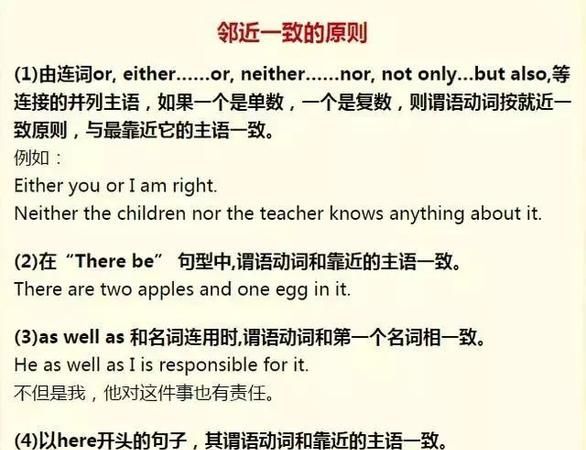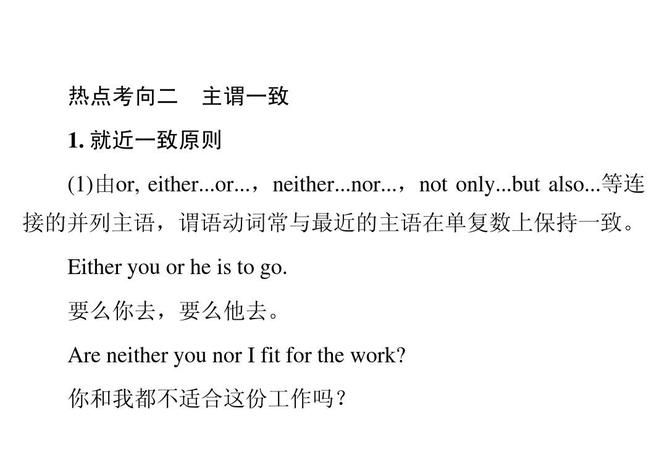本文目录
主谓一致ppt课件
可能用不着考虑就近不就近,因为后面用了its(to alter its attitude to racial problems),提示为三单。

Not only but also怎么用?
主要用法就是谓语动词要遵循“就近一致原则”,Not only the students but also the teacher was invited. 不仅学生们被邀请,而且那位教师也被邀请了
(以下为详细用法)
“not only … but also …”是一个并列连词词组,其意思基本等于“both … and …”,但侧重点放在“but also”上,另外该词组使用时须遵守一定的规则,如要求对称,倒装及主谓一致等。以下两个句子往往被看作是欠妥或错误的:
1. *Sitting up late last night,Tom not only read the assignment but also many poems by his favourite poet.
2. *Not only the students but also the teacher were invited.
上述两句第一句欠妥,第二句是错误的,应分别改为:1. Sitting up late last night,Tom read not only the assignment but also many poems by his favourite poet. 昨晚汤姆熬至深夜,不仅看了课外作业,而且读了他最喜欢的一位诗人的许多诗歌。 2. Not only the students but also the teacher was invited. 不仅学生们被邀请,而且那位教师也被邀请了。 下面就来谈谈正确使用该词组时须注意的几点事项及其常见的几种变体形式。
一、使用not only … but also … 时须注意的几点:
1. not only与but also后面所连接的词的词性必须对等:
(1) Frankin was considered not only an inventor,but also a statesman. 富兰克林不仅被看作发明家,而且被看作政治家。
(2) The nurse was not only competent but also kind. 这位护士不仅能干而且亲切和蔼。 (3) They not only broke into his office and stole his books,but also tore up his manuscripts. 他们不仅闯进他的办公室,偷走了他的书,而且还撕掉了他的手稿。
(4) Not only you but also she has to attend the ceremony. 不令你而且她也得参加典礼。
(5) In production,we should always keep an eye not only on quantity but also on quality. 在生产中,我们不仅要关注数量,而且要关注质量。
(6) They completed the project not only punctually but also perfectly. 他们不仅准时完成工程,而且完成得很出色。 2. not only只能连用,而but also既可连用,也可分开用: a. He speaks not only English,but also French. 他不仅说英语,还说法语。 b. Television is not only boring,but it also wastes a lot of time. 电视不仅乏味,而且还浪费许多时间。 c. She was not only compelled to stay at home,but she was also forbidden to see her friends. 她不仅被强迫蹲在家中,而且被禁止去看朋友。 3.谓语动词的数应与but also后主语的数保持一致: Not only you but also Mr Zhang teaches in this college. 不仅你,张老师也在此学院教书。
4. not only放在句首,后接句子时要用倒装结构:
(1) Not only should proletarians emancipate themselves but also the whole mankind. 无产者不仅要解放他们自己,而且要解放全人类。
(2) Not only does television appeal to those who can read but to those who cant. 电视不仅吸引阅读的人,而且也吸引了不会阅读的人。
(3) Not only was everythin

主谓一致就远原则
主谓一致
1,四大就近原则:
not only ……but also
neither……nor……
either……or
not……but
例句:Not only I but also he is happy.
2,四大就远原则:
as well as
with
but/beside/except
rather than
例句:I as well as he am happy.
3,分数与百分数和主语连接。
除population较特殊,与分数,百分数连用的时候总看作复数,其他情况下由后面修饰的名词决定。
4,定冠词与形容词共同构成主语。
定冠词:"the" +形容词。
表示一类人谓语动词看复数,表示一类物的谓语动词用单数。
1) 语法形式上要一致,即单复数形式与谓语要一致。
2) 意义上要一致,即主语意义上的单复数要与谓语的单复数形式一致。
3) 就近原则,即谓语动词的单复形式取决于最靠近它的词语,
一般来说,不可数名词用动词单数,可数名词复数用动词复数。
There is much water in the thermos.
但当不可数名词前有表示数量的复数名词时,谓语动词用复数形式。
Ten thousand tons of coal were produced last year.
1 并列结构作主语时谓语用复数
Reading and writing are very important.
注意: 当主语由and连结时,如果它表示一个单一的概念,即指同一人或同一物时,谓语动词用单数,and 此时连接的两个词前只有一个冠词。
The iron and steel industry is very important to our life.
典型例题
The League secretary and monitor ___ asked to make a speech at the meeting.
A. is B. was C. are D. were
答案B. 注: 先从时态上考虑。这是过去发生的事情应用过去时,先排除A.,C.。本题易误选D,因为The
League secretary and monitor 好象是两个人,但仔细辨别, monitor 前没有the,在英语中,当一人兼数职时只在第一个职务前加定冠词。后面的职务用and 相连。这样本题主语为一个人,所以应选B。
2 主谓一致中的靠近原则
1)当there be 句型的主语是一系列事物时,谓语应与最邻近的主语保持一致。
There is a pen, a knife and several books on the desk..
There are twenty boy-students and twenty-three girl-students in the class.
2)当either… or… 与neither… nor, 连接两个主语时,谓语动词与最邻近的主语保持一致。 如果句子是由here, there引导,而主语又不止一个时,谓语通常也和最邻近的主语一致。
Either you or she is to go.
Here is a pen, a few envelops and some paper for you.
3 谓语动词与前面的主语一致
当主语后面跟有with, together with, like, except, but, no less than, as well as 等词引起的短语时,谓语动词与前面的主语一致。
The teacher together with some students is visiting the factory.
He as well as I wants to go boating.
4 谓语需用单数
1) 代词each和由every, some, no, any等构成的复合代词作主语,或主语中含有each, every, 谓语需用单数。
Each of us has a tape-recorder.
There is something wrong with my watch.
2) 当主语是一本书或一条格言时,谓语动词常用单数。
The Arabian Night is a book known to lovers of English.
<<天方夜谭>>是英语爱好者熟悉的一本好书。
3) 表示金钱,时间,价格或度量衡的复合名词作主语 时,通常把这些名词看作一个整体,谓语一般用单数。(用复数也可,意思不变。)
Three weeks was allowed for making the necessary preparations.
Ten yuan is enough.
5 指代意义决定谓语的单复数
1) 在代词what, which, who, none, some, any, more, most, all等词的单复数由其指代的词的单复数决定。
All is right. (一切顺利。)
All are present. (所有人都到齐了。)
2) 集体名词作主语时,谓语的数要根据主语的意思来决定。如family, audience, crew, crowd, class,
company, committee等词后用复数形式时,意为这个集体中的各个成员,用单数时表示该个集体。
His family isn't very large. 他家不是一个大家庭。
His family are music lovers. 他的家人都是音乐爱好者。
但集合名词people, police, cattle, poultry等在任何情况下都用复数形式。
Are there any police around?
3)有些名词,如variety, number, population, proportion, majority 等有时看作单数,有时看作复数。
A number of +名词复数+复数动词。
The number of +名词复数+单数动词。
A number of books have lent out.
The majority of the students like English.
6 与后接名词或代词保持一致
1) 用half of, part of, most of, a portion of 等词引起主语时,动词通常与of后面的名词,代词保持一致。
Most of his money is spent on books.
Most of the students are taking an active part in sports.
2) 在一些短语,如 many a 或 more than one 所修饰的词作主语时,谓语动词多用单数形式。但由
more than… of 作主语时,动词应与其后的名词或代词保持一致。
Many a person has read the novel. 许多人都读过这本书。

notonlybutalso是否就近原则
如果not only... but also连接两个主语,谓语动词在人称和数上应与后面一个主语保持一致,也就是要适用就近原则。
例如: Not only he but also you are wrong.
不但他错了,你也错了。
在正常语序中: not only … but also 应连接两个相对称的并列成分。
例如:
Not only Mr Lin but also his son joined the Party two years ago. (连接两个主语)

扩展资料
就近原则也称“邻近原则”“就近一致原则”,即:谓语与靠近的名词、代词(有时不一定是主语)在“人称、数”上一致。与其相对的还有“就远原则”。
在倒装句中:谓语可与后面第一个主语一致。
例句:
In the distance was heard the clapping of hands and the shouts of the people . 在远处,能听见鼓掌声和人们的呼喊声。
There is a pen and some books on the desk.桌上有一支钢笔和几本书。
There are some books and a pen on the desk.桌子上有几本书和一支钢笔。
参考资料:就近原则_百度百科
以上就是关于主谓一致not only but also ,主谓一致ppt课件的全部内容,以及主谓一致not only but also 的相关内容,希望能够帮到您。

